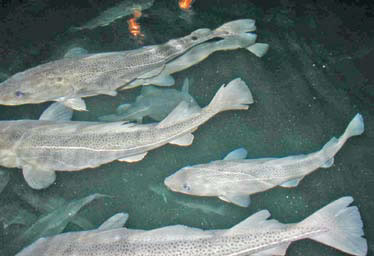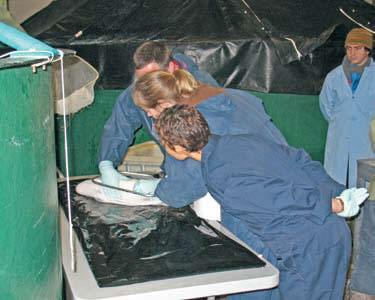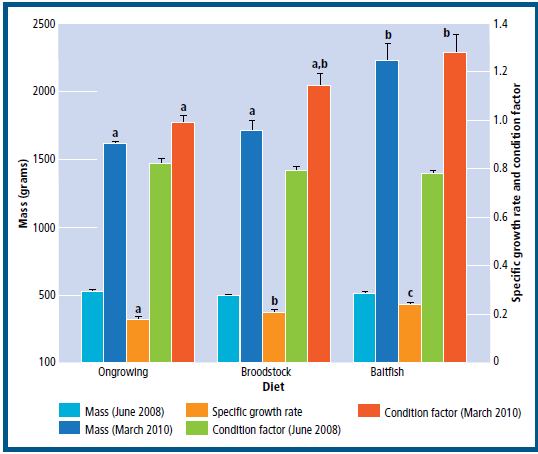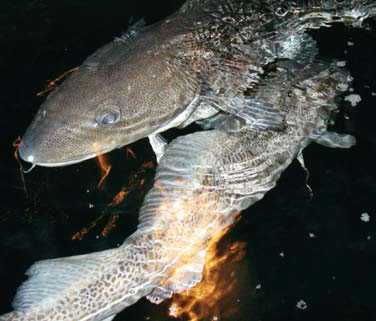Aquaculture Collaborative Research and Development Program (ACRDP) Fact Sheet
Issue 9 - January, 2011
Summary
Good nutrition is fundamental for raising healthy broodstock and for the production of high quality gametes. Previous work in Atlantic Canada has led to the development of a standard diet made of wild fish (herring, mackerel, and squid) with vitamin supplementation. However, a wild fish diet has numerous drawbacks including, inconsistent supply, unpredictable quality, prohibitive costs, and high risk for disease transfer. This project will determine the influence of diets on the spawning and growth of first generation photomanipulated cod broodstock. These diets include 1) a commercial on-growing pellet, 2) an experimental manufactured pellet (marine finfish broodstock formulation), and 3) the current standard diet of wild fish, supplemented with vitamins. This study will enhance our understanding of the nutritional requirements of cod broodstock, in order to improve reproductive performance in support of the long-term sustainability of cod culture in Canada. Results show that a commercial on-growing diet is inadequate for young broodstock and that the broodstock experimental diet may contribute to an improvement of the reproductive performance over the on-growing diet.
Introduction

Figure 1
Photomanipulated cod broodstock in experiment tank.
Reproductive performance and egg quality are influenced by ration size or nutrients such as proteins, lipids, minerals, vitamins in both marine and freshwater fish. In Atlantic Canada, the use of wild broodstock in commercial hatcheries has led to the development of a standard diet made of wild (herring, mackerel, and squid) with vitamin supplementation. However, a wild fish diet has numerous drawbacks including, inconsistent supply, unpredictable quality, prohibitive costs, and high risk for disease transfer. Moreover, the use of unprocessed products, such as wild fish, does not always provide adequate levels of nutrients. This project aims to determine the influence of different diets on the spawning and growth of first generation photomanipulated cod broodstock (Figure 1).
These diets include: 1) a commercial on-growing pellet, 2) a new commercial manufactured pellet still unused in Canada (marine finfish broodstock formulation), and 3) the current standard diet of wild fish, supplemented with vitamins. The research team of DFO scientists, in collaboration with the Newfoundland Cod Broodstock Company, is investigating the effect of these diets on fish condition, gamete quality, egg fertilization, larval performance, post-spawning condition, and recrudescence (recovery from spawning).
Methods
All fish used for this study were kept in seawater tanks at the Joe Brown Aquatics Building (Memorial University of Newfoundland) as part of an elite cod broodstock development project (http://www.codgene.ca). Three diets tested for this study included: 1) a commercial on-growing pellet, 2) an experimental manufactured pellet (marine finfish broodstock formulation), and 3) a standard diet of wild fish supplemented with vitamins. The compositions of the two commercial pelleted diets (on-growing and broodstock) were compared to show relative contribution of the principle nutrient components (Table 1).

Table 1.
Composition of commercially-produced on growing and broodstock diets as provided by manufacturers (Pr = Protein, L= Lipid, F=Fiber, A= Ash, Phos = Phosphorus, VitA = Vitamin A, VitD3 = Vitamin D3 , VitE = Vitamin E, O = On-growing diet, B = Broodstock diet).
Naïve (young inexperienced spawners) F1 Atlantic cod ( Gadus morhua) broodstock of 2 years of age were assigned to 6 duplicate tanks with 20 fish per tank. To minimize genetic differences among treatment groups, fish were selected equally from 13 families. Fish spawned for the first time in May 2008, and were immediately transferred to 15m3 tanks. Feeding trials were begun following 2 months of acclimatization. Fish were held under a photo-advanced light regime using a phase shift photoperiod, four months advanced from the ambient light period. Light/dark cycles were adjusted every five days using a computerized timer connected to the tank light source. Temperatures were controlled at an average of 6.3 °C throughout spawning with total annual temperature range being 5-11 °C due to natural fluctuations in ambient seawater temperatures and chilling capacity of the facility.
The fish spawned for the first time in May 2008. Two subsequent spawning events were monitored; February 2009 (second spawning), and October-November 2009 (third spawning). Crosses among families were completed by strip-spawning, while taking into account levels of relatedness to avoid crossing siblings (Figure 2). Egg quality was assessed by observing blastomere normality, fertilization and hatching rates, and egg diameters. Sperm quality was monitored using a quick evaluation of motility under the microscope and establishing a ranking of samples.

Figure 2
Strip-spawning of photomanipulated cod at the Joe Brown Aquatics Building, Memorial University.
Results
Growth and Condition Factor
Statistical analysis indicated that there was no significant tank effect therefore all growth data were grouped by diet irrespective of replicate (tank) number.
The results showed that fish fed the wild fish diet demonstrated significantly higher growth rates in comparison to those fed the pelleted diets (Figure 3). Analysis of condition factor (CF) data from March 2010 showed that differences existed between fish fed the wild fish diet and the broodstock diets. Additionally, for both of these diets, the fish fed the wild fish diet were in better condition than those that were fed the on-growing diet. These differences were significant only when wild fish-fed fish were compared to the on-growing diet group. No statistical differences in CF were found between broodstock diet and wild fish diet fed fish.

Figure 3
Fish wet weight (mass), specific growth rate and condition factor for each diet. Standard deviation bars indicated. Different letters denote statistically significant differences.

Table 2.
Ranking of sperm motility (No motility detected (0); little motility detected and slow movement (1); over half motile and movement not vigorous (1.5); vast majority motile and swimming actively (2); all cells are vigorously motile (2.5)). Different letters denote statistically significant differences.
Sperm and egg quality
A quick assessment of sperm quality revealed higher values for males fed either the broodstock diet or the wild fish diet compared to those fed the on-growing diet (Table 2).
There were no observable differences in egg quality, blastomere normality, fertilization rates and hatching rates among treatment groups at the January 2009 spawning event. Interestingly, a significant difference was found in both fertilization rates and hatching rates at the October 2009 spawning (Figure 4).

Figure 4
Comparison of fertilization and hatching rates between fish fed different diets (October 2009 spawning). Standard deviation bars indicated. Different letters denote statistically significant differences.
It should be noted that the fertilization rates and hatching rates observed in this study were low, as broodstock employed herein were young spawners (2 years old at the initiation of the experiment).
Larval length
Growth data showed that progeny of wild fish-fed broodstock families had a significant higher standard length than progeny from the other families that were fed either the on-growing or broodstock diet. The lowest standard lengths were associated with progeny produced from parents fed with the on-growing diet.

Table 3.
Standard length of larvae at 25 days post-hatch (October 2009). Different letters denote statistically significant differences.

Conclusions
In broodfish, a large portion of feed energy is used for reproductive activities instead of somatic growth. The on-growing diet seems to provide insufficient energy and nutrients as negative effects were seen on growth and fish reproductive performance. Our results suggest that the broodstock experimental diet may improve reproductive performance, compared to the regular on-growing diet, even if the gold standard remains the wild fish diet. Similarly, growth data shows that the fish fed the experimental broodstock diet had equivalent condition factors as the fish fed the wild fish diet. These observations suggest that the common on-growing diet is inappropriate for young broodstock. The knowledge gained from this study will play a role in the development of an effective cod broodstock diet that will better position cod aquaculture for future development in Canada as an aquaculture species.
This ACRDP project (N-08-01-001) is a collaborative effort among the Department of Fisheries and Oceans (DFO Science) and Newfoundland Cod Broodstock Company. The lead scientist on this project, Dr Dounia Hamoutene, can be contacted at Dounia.Hamoutene@dfo-mpo.gc.ca.
For further information on this and other ACRDP projects, visit: /aquaculture/acrdp-pcrda/index-eng.htm.
Published by:
Aquaculture Science Branch
Fisheries and Oceans Canada
Ottawa, Ontario K1A 0E6
©Her Majesty the Queen in Right of Canada 2011
ISSN 1919-6806 (Print)
ISSN 1919-6814 (Online)
DFO/2008-1493
French version and alternative formats available through: /aquaculture/acrdp-pcrda/index-fra.htm.
- Date modified: